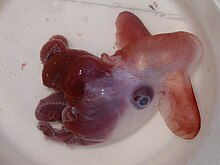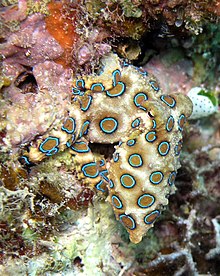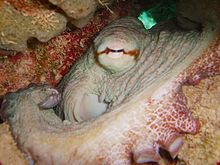OCTOPUS

Octopuses are characterized by their eight arms, usually bearing suction cups. The arms of octopuses are often distinguished from the pair of feeding tentacles found in squid and cuttlefish.[18] Both types of limb are muscular hydrostats.
Octopuses can be divided into two suborders, the Incirrina (or Incirrata) and the Cirrina (or Cirrata). The incirrate octopuses are distinguished from the cirrate octopuses by their absence of "cirri" filaments (found with the suckers), as well as by the lack of paired swimming fins on the head. Unlike most other cephalopods, the majority of octopuses – those in the Incirrina – have almost entirely soft bodies with no internal skeleton. They have neither a protective outer shell like the nautilus, nor any vestige of an internal shell or bones, like cuttlefish or squid. The beak, similar in shape to a parrot's beak, and made of chitin, is the only hard part of their bodies. This enables them to squeeze through very narrow slits between underwater rocks, which is very helpful when they are fleeing from moray eels or other predatory fish. The octopuses in the less-familiar Cirrina suborder have two fins and an internal shell, generally reducing their ability to squeeze into small spaces. These cirrate species are often free-swimming and live in deep-water habitats, while incirrate octopus species are found in reefs and other shallower seafloor habitats.
Octopuses have a relatively short life expectancy, with some species living for as little as six months. Larger species, such as the giant pacific octopus, may live for up to five years under suitable circumstances. However, reproduction is a cause of death: males can live for only a few months after mating, and females die shortly after their eggs hatch. They neglect to eat during the (roughly) one-month period spent taking care of their unhatched eggs, eventually dying of starvation. In a scientific experiment, the removal of both optic glands after spawning was found to result in the cessation of broodiness, the resumption of feeding, increased growth, and greatly extended lifespans.[19]
Octopuses have three hearts. Two branchial hearts pump blood through each of the two gills, while the third is a systemic heart that pumps blood through the body. Octopus blood contains the copper-rich protein hemocyanin for transporting oxygen. Although less efficient under normal conditions than the iron-rich hemoglobin of vertebrates, in cold conditions with low oxygen pressure, hemocyanin oxygen transportation is more efficient than hemoglobin oxygen transportation. The hemocyanin is dissolved in the plasma instead of being carried within red blood cells, and gives the blood a bluish color. The octopus draws water into its mantle cavity, where it passes through its gills. As molluscs, octopuses have gills that are finely divided and vascularized outgrowths of either the outer or the inner body surface.
Defense
The octopus's primary defense is to hide or to disguise itself through camouflage and mimicry.[39] Octopuses have several secondary defenses (defenses they use once they have been seen by a predator). The most common secondary defense is fast escape. Other defenses include distraction with the use of ink sacs and autotomising limbs.
Most octopuses can eject a thick, blackish ink in a large cloud to aid in escaping from predators. The main coloring agent of the ink is melanin, which is the same chemical that gives humans their hair and skin color. This ink cloud is thought to reduce the efficiency of olfactory organs, which would aid evasion from predators that employ smell for hunting, such as sharks. Ink clouds of some species might serve as pseudomorphs, or decoys that the predator attacks instead.[40]
The octopus's camouflage is aided by certain specialized skin cells which can change the apparent color, opacity, and reflectivity of the epidermis. Chromatophores contain yellow, orange, red, brown, or black pigments; most species have three of these colors, while some have two or four. Other color-changing cells are reflective iridophores, and leucophores (white).[41] This color-changing ability can also be used to communicate with or warn other octopuses. The highly venomous blue-ringed octopus becomes bright yellow with blue rings when it is provoked. Octopuses can use muscles in the skin to change the texture of their mantle to achieve a greater camouflage. In some species, the mantle can take on the spiky appearance of seaweed, or the scraggly, bumpy texture of a rock, among other disguises. However, in some species, skin anatomy is limited to relatively patternless shades of one color, and limited skin texture. It is thought that octopuses that are day-active and/or live in complex habitats such as coral reefs have evolved more complex skin than their nocturnal and/or sand-dwelling relatives.[39]
When under attack, some octopuses can perform arm autotomy, in a manner similar to the way skinks and other lizards detach their tails. The crawling arm serves as a distraction to would-be predators. Such severed arms remain sensitive to stimuli and move away from unpleasant sensations.[42]
A few species, such as the mimic octopus, have a fourth defense mechanism. They can combine their highly flexible bodies with their color-changing ability to accurately mimic other, more dangerous animals, such as lionfish, sea snakes, and eels.[43][44]
Reproduction
When octopuses reproduce, the male uses a specialized arm called a hectocotylus to transfer spermatophores (packets of sperm) from the terminal organ of the reproductive tract (the cephalopod "penis") into the female's mantle cavity.[45] The hectocotylus in benthic octopuses is usually the third right arm. Males die within a few months of mating. In some species, the female octopus can keep the sperm alive inside her for weeks until her eggs are mature. After they have been fertilized, the female lays about 200,000 eggs (this figure dramatically varies between families, genera, species and also individuals).[citation needed]
Cohabitation
Pacific striped octopuses share food and habitation but most other octopuses are solitary outside of mating.[46]
Senses
Octopuses have keen eyesight. Like other cephalopods, they can distinguish the polarization of light. Color vision appears to vary from species to species, being present in O. aegina but absent in O. vulgaris.[47] Attached to the brain are two special organs, called statocysts, that allow the octopus to sense the orientation of its body relative to horizontal. An autonomic response keeps the octopus's eyes oriented so the pupil slit is always horizontal.[citation needed]
Octopuses also have an excellent sense of touch. The octopus's suction cups are equipped with chemoreceptors so the octopus can taste what it is touching. The arms contain tension sensors so the octopus knows whether its arms are stretched out. However, it has a very poor proprioceptive sense. The tension receptors are not sufficient for the brain to determine the position of the octopus's body or arms. (It is not clear whether the octopus brain would be capable of processing the large amount of information that this would require; the flexibility of the octopus's arms is much greater than that of the limbs of vertebrates, which devote large areas of cerebral cortex to the processing of proprioceptive inputs.) As a result, the octopus does not possess stereognosis; that is, it does not form a mental image of the overall shape of the object it is handling. It can detect local texture variations, but cannot integrate the information into a larger picture.[48]



No comments:
Post a Comment